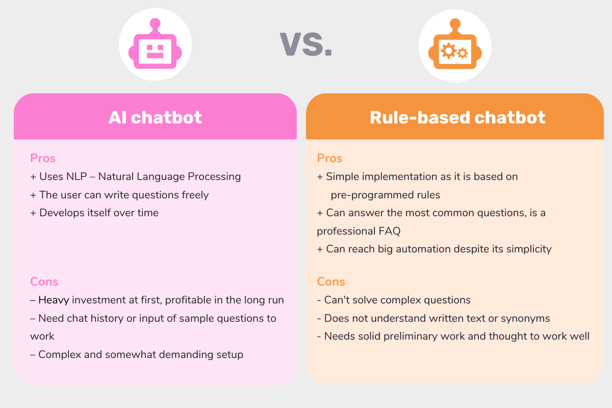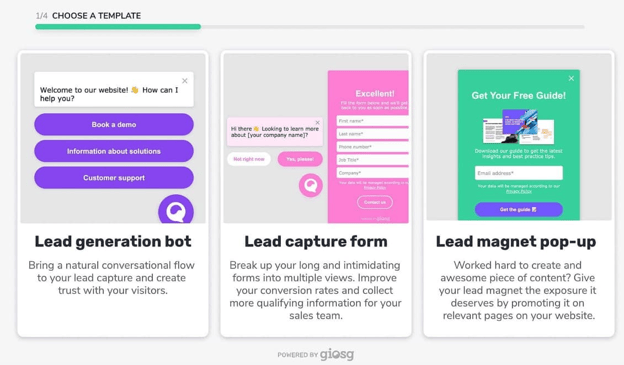It has hardly escaped anyone that artificial intelligence, or as it is shortened; AI, is a buzzword right now.
There is a lot of information on the subject, and we have become accustomed to headlines saying that AI bots will soon surpass human intelligence.
But is this really the case? What does the reality of it all truly look like?

In this blog, we want to demonstrate that automation does not necessarily mean complicated AI technology.
Although AI and rule-based chatbots come in all shapes and sizes; basically, they all are about the same thing – automating one or more processes.
So without further ado...
What’s the difference between AI chatbots and rule-based chatbots?
The main thing that separates the two is that AI chatbots allow the user to dictate the conversation, whereas rule-based chatbots make users follow a pre-programmed conversation flow.
Here’s a quick cheat sheet to differentiate the two:

To fully understand AI and its role in chatbots, check out our full article on everything there is to know about AI chatbots.
But to give you a quick run-through, an AI chatbot is a chat controlled by a robot that uses artificial intelligence. But what about rule-based chatbots?
Let's dive in a bit deeper.
What is a rule-based chatbot?
A rule-based chatbot, on the other hand, is also a form of automation that is somewhat less technically complex.
A rule-based bot is a set of predetermined rules that behave in a particular way based on the user's behavior and responses.
By guiding the visitor in already predetermined directions, many of the frequently asked questions can be answered by the visitor serving himself.
Below we show three examples of common rule-based bots that do not use AI technology but still utilize automation:

It may go without saying, but:
✅ this decision tree automation type is easier to start with. This is because the chatbot only needs a certain amount of data to deliver information, and the entire setup can be done in one go.
But with advantages come disadvantages.
With a rule-based chatbot, the user can only enter what the chatbot is programmed for.
The chatbot is unable to develop itself as it does not learn from previous chats but runs its own race. In other words
⛔️ this flow type does not collect valuable user data, making it a difficult tool for further development, and instead requires some essential preparatory work.
Examples of use cases when rule-based chatbots show their best features
A rule-based bot is perfect in situations where you have to give standard answers or answers based on a computer system. For example:
- in booking a table at a restaurant
- providing the visitor with the delivery time and tracking code of their purchased order, or other straightforward cases.
Which one should I choose, AI chatbots or rule-based chatbots?
Do you have a lot of chat history from your website that can be fed into a technical system, or are you ready to start a larger project to build a solid chatbot eventually?
If you are also prepared to open your wallet to automate parts of your website, then an AI chatbot may be the solution you are looking for.
If, on the other hand, you have a more straightforward website with many recurring questions and actions from your visitors, a rule-based chatbot flow may be the ultimate solution.
Despite the simplicity of constructing a rule-based chatbot flow, we would like to emphasize that a rule-based flow can do wonders for your website by considerably relieving the workload of your customer service team when the pre-work has been well thought out.
How to get started with the right solution for your company
It is important not to categorize the comparison between a rule-based flow and an AI chatbot as black and white – both help you do the same thing; automate, streamline and improve your processes.
There are also several cases where combining both parts can be the solution. Not to mention using live chat's best features to complement your automated support.
Your automation solution should be tailored to your company's needs and size for the best results.
Giosg for example offers an excellent solution for setting up custom flows that allow you to optimize the right chatbot type for the situation at hand.
Combining chatbots in this way is called hybrid chatbots, and maybe this will be the upcoming trend to watch out for – to bring the gold nuggets from the various chatbots to create an even more golden combination.
To learn more about chatbots and their value for your business, book a meeting with our experts. Giosg can help you determine what your company needs to meet your objectives and automation requirements!